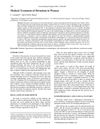Effect of IGF-I on Hair Growth Is Related to the Anti-Apoptotic Effect of IGF-I and Up-Regulation of PDGF-A and PDGF-B
January 2012
in “
Annals of Dermatology
”
TLDR IGF-I promotes hair growth by keeping hair follicles in the growth phase longer.
The study found that insulin-like growth factor-I (IGF-I) promoted hair growth by extending the anagen phase and increasing hair growth rate in an organ culture model of 140 hair follicles from 3 individuals. IGF-I enhanced hair growth to 0.10 mm/day compared to 0.08 mm/day in the control group and maintained 70.8% of hair follicles in the anagen phase by day 12, versus 45.8% in controls. This effect was linked to IGF-I's anti-apoptotic properties and the upregulation of platelet-derived growth factors PDGF-A and PDGF-B, preventing hair follicles from entering the catagen phase.








